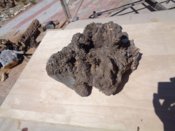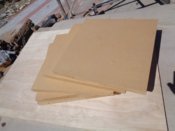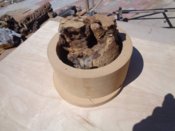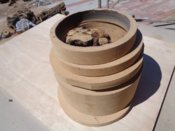Several years ago, I saw a form posted by Alan Trout on another will not be named turning site that was Agarita and Alumilite. It was an absolutely beautiful turning, and I was determined to find out more.
My absolute passion is Flintknapping, and I have a friend in San Antonio, also where Alan Trout lives. So, when there to go to a knapin nearby, I visited Alan and actually handled the piece that I had only seen pictures of. It was better in real life, so I asked questions and got some good education from him.
After getting back home, I managed to scrape up several hundred dollars to get an order from Alumilite Corp. Ordered the Water Clear, some different colors and several powders.
The first task at hand is to determine what type of trash wood I want to turn. Here are 3 examples of some of the wood I like turning. Here is one example.

Here are 3 more pieces of rough turned Mesquite, and oak. The large gaps voids you can see get stuffed with pieces of the same wood, mostly pieces that I either cut or broke off the piece before it went onto my lathe

This next picture are the mdf pieces I cut to make the mold. My paint tank is about 9" ID, so these are cut about 8 3/4" square.

After glue up and cure time, they are cut on the bandsaw.

The round is then mounted to a face plate, and then trued round on the od, and the center is actually parted off to match the OD of the blank that will be cast. (I sure hope these in order.)
Piece inserted into the main mold. As you can see, there is more to do.
I need more height. Normally, I would do the same as in the previous picture, but sometimes I don't need the total depth, so I just glue up individual rings as needed. I sometimes make the height about 1 1/2" higher than the piece being cast as I don't really know whether the resin will settle fast enough or I'll have too much
Ignore the resin here, but here are the tooth picks I use to get clearance for the resin to migrate to the bottom. I used to insert a screw through the bottom, but with some of the woods I use, a screw wouldn't work. The screws and or toothpicks are there to keep the piece from floating
Should be the bottom here. I use a glue block so when the turning is cast, I'll at least have a tenon to mount into. Notice the screw hole. It applies to the failure picture.
Success, but barely. My resin was just short of covering the bottom of this piece. When I get this turned, no one will ever notice that it was a short pour. More pictures to come. This is all I'm allowed at this time.
More pictures to come. This is all I'm allowed at this time.
My absolute passion is Flintknapping, and I have a friend in San Antonio, also where Alan Trout lives. So, when there to go to a knapin nearby, I visited Alan and actually handled the piece that I had only seen pictures of. It was better in real life, so I asked questions and got some good education from him.
After getting back home, I managed to scrape up several hundred dollars to get an order from Alumilite Corp. Ordered the Water Clear, some different colors and several powders.
The first task at hand is to determine what type of trash wood I want to turn. Here are 3 examples of some of the wood I like turning. Here is one example.

Here are 3 more pieces of rough turned Mesquite, and oak. The large gaps voids you can see get stuffed with pieces of the same wood, mostly pieces that I either cut or broke off the piece before it went onto my lathe

This next picture are the mdf pieces I cut to make the mold. My paint tank is about 9" ID, so these are cut about 8 3/4" square.

After glue up and cure time, they are cut on the bandsaw.

The round is then mounted to a face plate, and then trued round on the od, and the center is actually parted off to match the OD of the blank that will be cast. (I sure hope these in order.)

Piece inserted into the main mold. As you can see, there is more to do.

I need more height. Normally, I would do the same as in the previous picture, but sometimes I don't need the total depth, so I just glue up individual rings as needed. I sometimes make the height about 1 1/2" higher than the piece being cast as I don't really know whether the resin will settle fast enough or I'll have too much

Ignore the resin here, but here are the tooth picks I use to get clearance for the resin to migrate to the bottom. I used to insert a screw through the bottom, but with some of the woods I use, a screw wouldn't work. The screws and or toothpicks are there to keep the piece from floating

Should be the bottom here. I use a glue block so when the turning is cast, I'll at least have a tenon to mount into. Notice the screw hole. It applies to the failure picture.

Success, but barely. My resin was just short of covering the bottom of this piece. When I get this turned, no one will ever notice that it was a short pour.
 More pictures to come. This is all I'm allowed at this time.
More pictures to come. This is all I'm allowed at this time.
Last edited:





